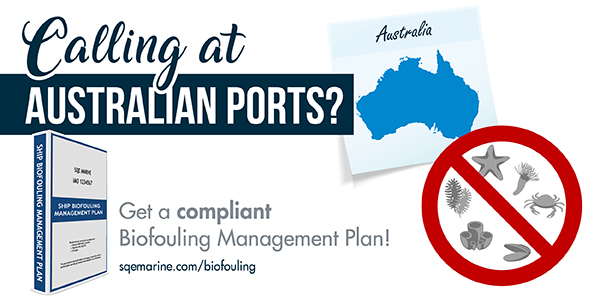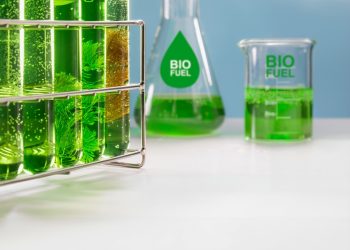In June 2022, new requirements on biofouling management entered into force for ships in Australia, reminding us that the problem is yet to reach its peak, amid a continuous increase in seaborne trade. What is biofouling and why is it recognized as a major threat to the wellbeing of the planet?
Biofouling is defined as the accumulation of aquatic organisms such as plants, animals, and micro-organisms on surfaces and structures submerged or exposed to the aquatic environment. This makes it a significant risk for the marine environment and a key threat directly posed by international shipping, as vessels transfer these micro-organisms, known as invasive aquatic species, to new ecosystems in different regions, threatening their balance.
For the record, there are two ways in which ships transfer invasive species: One is biofouling (or hull fouling) which means they are transferred on ships’ hull and the other is ballast water, which means they are transferred through ships’ ballast tanks, an environmental issue that the IMO’s BWM Convention is aiming to address since it entered into force in 2017.
3 reasons why biofouling is a problem
#1 Threat to biodiversity: The main reason why biofouling threatens the marine environment is the disruption it causes to the native species. For example, if a species enters a new environment and starts multiplying at a fast pace, it may start consuming the prey of other species, causing the latter to collapse. This collapse of a specific population may lead to devastating consequences for other populations as well, through the food web. In other cases, invasive species may carry disease, prevent native species from reproducing or be aggressive towards the native species. For example, lake trout are native to the Great Lakes, but are considered an invasive species in Yellowstone Lake in Wyoming because they compete with native cutthroat trout for habitat.
Did you know?
More than 5% of the marine species in the Mediterranean Sea are now considered non-native species, according to data by the Archipelagos Institute of Marine Conservation. This amounts to over 986 alien species in the Mediterranean.
#2 Increased shipping costs: The adverse effects of biofouling are not limited to the marine environment. Research shows that a heavily fouled ship hull can result in up to 86% speed decrease in typical cruising speeds, while a lightly fouled hull can bring up to 10-16% speed loss. This means the ship becomes less efficient, which consequently means more fuel consumption and, thus, more emissions and higher operating costs. To put this into context, the total estimated cost of hull fouling for the US Navy fleet is between $180-260 million per annum.
#3 Damage to industries: According to IMO, biofouling and invasive species bring significant economic impact to industries that depend on the coastal and marine environment, such as tourism, aquaculture, and fisheries, as well as costly damage to infrastructure.
DO YOU KNOW?: Read in this series
What are some invasive species carried on ships’ hulls?
This is a non-exhaustive list of high-profile Invasive Aquatic Species that are capable of being translocated via biofouling:
- Asian paddle crab (from North-west Pacific introduced to New Zealand)
- Colonial tunicate (from North-west Pacific introduced to North-east and north-west Atlantic, north-east Pacific, New Zealand)
- North Pacific seastar (from North-west Pacific introduced to North-east Pacific, Southern Australia)
- Asian green mussel (from the Persian Gulf – Philippines introduced to The Caribbean, South Atlantic, South Pacific)
- Black striped mussel (from North-west Atlantic, the Caribbean and South Atlantic introduced to India, East Asian Seas, South Pacific, North-west Pacific)
- European fan worm (from North-east Atlantic, Mediterranean introduced to South-west Atlantic, Southern Australia, New Zealand, North-west Pacific)
- Bay barnacle (from east coast of North-east and North-west Atlantic introduced to South-west Atlantic, Caribbean Sea, Atlantic, Baltic Sea, Black Sea, Caspian Sea, North-west Pacific, East Asia Seas)
- Wakame seaweed (from North-west Pacific introduced to Mediterranean, North-east Atlantic, South-west Atlantic, North-east Pacific, South-east Australia, New Zealand)
- European shore crab (from North-east Atlantic, The Baltic Sea introduced to West Africa, Mediterranean, North-west Atlantic, South-west Atlantic, East Africa, North-west Pacific, North-east Pacific, East Asian Seas, Central Indian Ocean, South Pacific, South-eastern Australia
What can prevent biofouling?
According to the IMO, the biofouling on a ship’s hull may be influenced by a range of factors, such as:
1. design and construction, particularly the number, location and design of niche areas (e.g., bow thrusters)
2. specific operating profiles, including parameters such as operating speeds, and where the ship is located when not in use (e.g., open anchorage or estuarine port);
3. places visited and trading routes (e.g., depending on water temperature and salinity, abundance of fouling organisms, etc.); and
4. maintenance history, including the type, age and condition of any anti-fouling coating.
As such, implementing practices to control and manage biofouling can greatly assist in reducing the risk of the transfer of invasive aquatic species. For example, antifouling is the process of protecting a ship’s hull with specifically designed materials, such as special paints, that prevent these organisms from piling up in the hull.
Current initiatives
The IMO has long ago identified the transfer of invasive aquatic species to new environments via ships as a major threat to the world’s oceans and to the conservation of biodiversity. For this reason, a Global Project Task Force launched in 2018 by the Global Environment Facility, UN Development Programme and IMO, as part of the GloFouling Partnership, has been providing training and educational material aiming to establish a global approach on how biofouling should be controlled and managed to reduce the transfer of invasive aquatic species. The 12 Lead Partnering Countries in the GloFouling Partnerships Project are Brazil, Ecuador, Fiji, Indonesia, Jordan, Madagascar, Mauritius, Mexico, Peru, the Philippines, Sri Lanka, and Tonga. Recently, the project was extended until 2025.
Regulatory framework on biofouling
More and more ports and regions have been implementing regulations to combat the effects of biofouling, with the following having established the most prevalent schemes:
California: From October 2017, biofouling regulations and reporting requirements have been in effect for vessels of 300 gross tons (GT) or more, calling a Californian port. These make mandatory a Biofouling Management Plan, a Biofouling Record Book and biofouling management of the vessel’s wetted surfaces, among others.
Australia: From 15 June 2022, vessel operators are required to report via MARS any information on the vessel’s biofouling management prior to entering Australian territorial seas. The information will then be used to target vessel interventions.
New Zealand: From May 2018, the country has set into force a strict, mandatory ‘clean hull’ requirement known as the “Craft Risk Management Standard (CRMS)”, under which vessels have to submit an Advanced Notice of Arrival, a biofouling and ballast water declaration, a Master’s declaration, details about the vessel’s antifouling coating and many more.
The IMO also issued the Biofouling Guidelines in 2011. Two years later, IMO shared guidance for evaluating the 2011 guidelines for the control and management of ships’ biofouling to minimize the transfer of invasive aquatic species.






































































































































